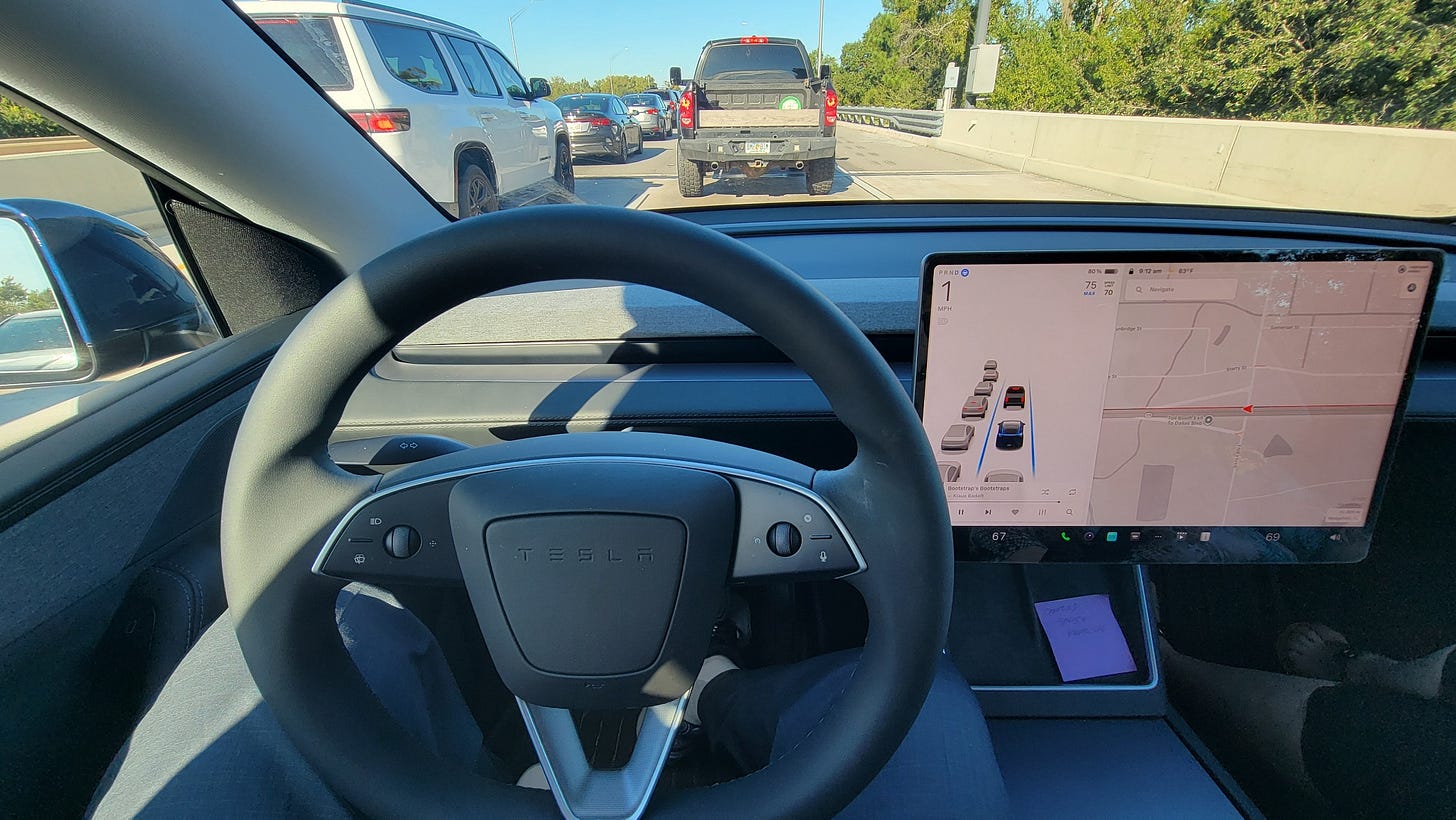Unsupervised
Full Self-Driving remains far from perfect. The same is true for its less capable sibling, Autosteer.
Autosteer tried to drive my Tesla head-on into these center divider pylons. Image source: Google Maps.
Is Tesla a car company?
If you said yes, Elon Musk would disagree with you.
“We should be thought of as an AI robotics company. If you value Tesla as just an auto company — it’s just the wrong framework,” Musk said in April 2024.
Tesla, in his view, is an automation company. In January 2025, Musk said:
I see a path of Tesla being the most valuable company in the world by far … And that is overwhelmingly due to autonomous vehicles and autonomous humanoid robots. So our focus is actually building towards that.
I wrote on August 23 about Tesla’s automation ambitions, including the Large Language Model known as Grok. The article discussed the occasional problems with Full Self-Driving, which Musk hopes will evolve into his Robotaxi service.
If you buy a Tesla today, you’ll have several automation options. Full Self-Driving is very expensive, at $99/month or a one-time lifetime payment of $8,000.
You have a cheaper option, called Autosteer.
Tesla will warn you that these various Autopilot options require supervision. During a recent test of Autosteer, I found supervision was not only a good idea, but a lifesaver.
According to the Tesla Model Y manual:
Autosteer maintains a set speed (if there is not a vehicle in front of you) or a set following distance (if there is a vehicle in front of you). In addition, Autosteer detects lane markings, road edges, and the presence of vehicles and objects to intelligently keep Model Y in its driving lane.
The first test was to drive my “Juniper” Model Y through Cape Canaveral to Cocoa Beach and back. This was around 9:15 AM, when the sun was above the horizon in the east, shining directly into the car’s forward-facing camera.
Several times, Autosteer appeared to be confused by color variations in the road, such as newly paved asphalt or pavement stripes. It also tended to follow a car ahead of it, even if the car wasn’t going in the direction I was. Twice the car tried to take an off-ramp, following a car ahead of me. I had to take manual control.
You can set speed limitations, e.g. five miles per hour over the speed limit. This worked sporadically. Sometimes the car kept accelerating 10-15 MPH above the speed limit.
The most dangerous incident was on the drive back. If you’re headed northbound on Highway A1A through Cape Canaveral, the road begins to veer west at Atlantic Avenue. It’s a controlled intersection, with traffic lights and center divider pylons for the left-turn lane from eastbound A1A to northbound Atlantic.
As I drove northbound on A1A, the car tried to steer me right into the pylons! I tried to turn the wheel but the car fought me for about two seconds. I was about to slam on the brakes, especially dangerous in the flow of traffic, when it finally let go.
I had better success with the second test, which was driving westbound on State Route 528, known as The Beachline, from Merritt Island to the Orlando airport.
SR-528 has few off-ramps. If there’s an accident, you’re pretty much stuck, and that’s what happened to us. We were caught in a seven-mile backup due to a traffic accident. It took about 45 minutes to clear. Our speed varied from 0-15 MPH.
Using Autosteer in bumper-to-bumper traffic.
In this controlled environment, Autosteer was a godsend. Because traffic was stop-and-go for 45 minutes, Autosteer relieved this stressed driver of the tedium. Autosteer prompted me every few minutes to slightly turn the wheel to prove I was supervising the drive, but otherwise I could relax.
I passed another Tesla driver who was also caught in the backup. His hands weren’t on the steering wheel either.
Autosteer no longer makes lane changes. Apparently this is due to National Traffic Safety Board concerns. If you activate the turn signal, Autosteer turns off. You’ll need Full Self-Driving (Supervised) for that feature.
I doubt I’ll make much use of Autosteer for now. It seems best suited for slow driving conditions, or a long stretch of highway where it has to make limited decisions.
Just remember … you’re the supervisor. The final decision is yours.



